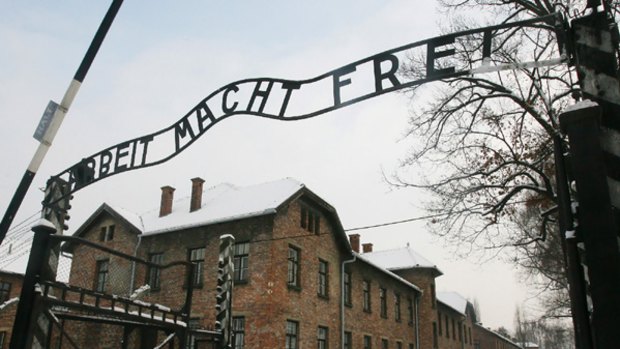This was published 14 years ago
The worst place in the world is deeply thought-provoking
By Cathy Alexander

Visiting Auschwitz is horrendous, unsettling, and deeply thought-provoking.Credit: AP
"Between two throw-ins in a soccer game, right behind my back, three thousand people had been put to death."
So wrote Tadeusz Borowski, survivor - and victim - of Auschwitz.
The Nazi concentration camp seems an unlikely tourist attraction. Stranded on the grey plains of southern Poland, its buildings and barbed wire fences carry an unbearable weight of sadness.
Visiting Auschwitz is horrendous, unsettling, and deeply thought-provoking. It takes the visitor to the depths of human depravity, to the very outer limit of what humankind is capable of.
It's not a comfortable realisation. But it's one that will affect the way I think for a long time.
Some of the death camp's buildings still stand, half a century after 1.1 million people, mostly Jews, were murdered there in World War Two.
Survivors gathered recently to mark the 65th anniversary of the camp's liberation on January 27, 1945.
Many of the tourists who visit the pretty nearby town of Kracow tour the World Heritage-listed camp coming in buses and tour groups.
Overweight English tourists sit outside the camp smoking. One is complaining about a poor meal the night before.
We walk beneath the sign saying "arbeit macht frei" (work makes you free), a few days before the sign is stolen and chopped into pieces. It's later found.
Some visitors are still behaving like tourists - they smile for photos in front of a scaffold, they text their friends.
But as they move through the camp, silence falls. There are no more photos.
By the time we move through the gas chamber and past the ovens there's not a sound.
So much horror crammed into one small room. It's too much to comprehend. People walk quickly and avoid each other's eyes. The soul sighs.
Outside, young men defiantly wave an Israeli flag.
And outside the fence there are houses and factories within a few hundred metres. What a place to live - within sight of the wooden towers which guard the ghosts of a million people.
That's partly what's so unsettling about a visit to Auschwitz. It's a mixture of horror and the mundane - tour groups, toilets, a snack shop.
It's not a particularly touristy experience however. The buildings have been kept as museums, signs are not obtrusive, and entry is free. A small shop stocks flowers to leave at the site.
One realisation which strikes the visitor is how organised and deliberate the extermination was. It only took the Nazis around two years to murder a million people here. It happened in cold blood.
The victims were brought from all over occupied Europe in cramped trains. When they pulled up at Auschwitz, authorities pulled some healthy people aside and the rest - including almost all the children and their mothers - went to the gas chamber, which was disguised as a shower block.
They were stripped and killed with a poison gas called Zyklon B. Their bodies were burnt in the ovens. The smoke billowed out over the countryside.
Another realisation is that the victims were not small ticks in some historical ledger; they were people. See the orphaned girl's suitcase in the museum, carefully labelled by someone who probably thought she was going to be resettled.
See the photo of an anguished, desperate young woman who knows she's going to die. She did.
See the room full of the victims' hair, their artificial limbs, their shoes. There's a pair of shoes like yours if you look long enough.
Some people don't want to visit Auschwitz because it would be too upsetting; others see it as voyeuristic. There is an element of that.
For me, there's nothing I can do to save the people who died at the camp. One very small thing I can do for them is to visit, hear the stories, lay a flower, and think that I would never, ever be a part of something like that.
So why was Tadeusz Borowksi, the author quoted at the start of the story, both a victim and a survivor of Auschwitz?
He survived the camp and was freed by the Russians in 1945. He wrote stories about the thousands of people he saw taken to the gas chambers. One is called "this way for the gas, ladies and gentlemen".
Six years after he left Auschwitz, and haunted by his experiences, Borowski opened a gas valve and took his own life.
IF YOU GO:
Easyjet has flights from London to Kracow, Poland, from STG41 ($A74.40) one-way. Auschwitz is about one hour's drive from Kracow.
Auschwitz is made up of two separate sites, 10 minutes' drive apart. Birkenau was the extermination camp. Auschwitz I was the main camp, and includes the museum. Guided and audio tours are available. The site is open every day from 8am.
Visit: http://en.auschwitz.org.pl.
Money: Poland is in the European Union but does not have the euro. The currency is the zloty.
AAP
Sign up for the Traveller Deals newsletter
Get exclusive travel deals delivered straight to your inbox. Sign up now.